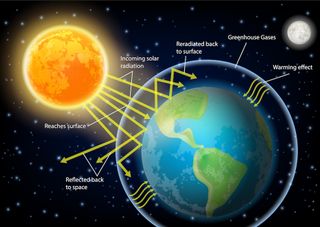What Is the Greenhouse Effect?
Reference Article: Facts about the greenhouse effect.

Earth is said to be in a perfect "Goldilocks zone" away from the sun (not too cold, and not too hot), which enables life to thrive on the planet's surface. But Earth's balmy temperatures would not be possible without the greenhouse effect, which traps solar energy on Earth's surface and keeps the planet warm.
The greenhouse effect arises from Earth's atmosphere. Visible light from the sun, as well as invisible ultraviolet and infrared wavelengths, can penetrate the gaseous layer that blankets our world. Roughly 70% of these energetic rays are absorbed by Earth's oceans, land and atmosphere, while the remaining 30% are immediately reflected back into space, according to NASA Earth Observatory.

As the planet's surface heats up, it releases some of the infrared energy that it had absorbed, but that energy doesn't make it back out of Earth's gaseous atmosphere. Instead of shooting back out into space, the infrared energy closely hugs our planet and, therefore, raises Earth's overall temperature. This is similar to how a human-built glass greenhouse works, trapping heat from the sun to keep plants warm in the winter.
Without an atmosphere, our world would be as cold as the lifeless moon, which has an average temperature of minus 243 degrees Fahrenheit (minus 153 degrees Celsius) on its far side. Because of the greenhouse effect, Earth maintains an overall average temperature of around 59 F (15 C).
Greenhouse gases and climate change
Greenhouse gases include several naturally occurring molecules — like water vapor, carbon dioxide, methane, nitrous oxide and ozone — as well as several manufactured ones, like chlorofluorocarbons, according to the Australian Department of the Environment and Energy. Over the past century or so, human activities — such as the burning of fossil fuels, intensive agriculture, livestock raising and land clearing — have dramatically increased the concentrations of greenhouse gases in Earth's atmosphere, to the point where it's changing our planet's climate.

Since the middle of the 20th century, greenhouse gases produced by humans have become the most significant driver of climate change, according to the U.S. Environmental Protection Agency. Carbon dioxide levels in the atmosphere have increased by more than 40% since the start of the Industrial Revolution, from roughly 280 parts per million (ppm) to more than 400 ppm today.
The last time Earth's atmosphere had similar carbon dioxide concentrations was during the Pliocene epoch, between 3 million and 5 million years ago, according to the Scripps Institution of Oceanography in San Diego. That's at least 2.8 million years before modern humans roamed the planet. Fossils show that forests grew in the Canadian Arctic during the Pliocene, and savannas and woodlands spread over what's now the Sahara desert.
While some people still doubt the reality of human-induced climate change, the evidence for it is overwhelming. Since the 1850s, the average global surface-air temperature has risen by around 1.4 F (0.8 C), and ocean temperatures are now at the highest levels ever recorded.
Increases in greenhouse gases in the coming decades are expected to harm human health, increase droughts, contribute to sea level rise, and decrease national security and economic well-being throughout the world.
The greenhouse effect on other planets
Because the greenhouse effect is a natural process, it affects other bodies in the solar system, too. And, in some cases, that provides a warning about how things can go awry. A perfect example of this is Venus, which is roughly the same size as Earth and not that much closer to the sun.
Billions of years ago, when the sun was cooler and dimmer, Venus may have had a temperate climate that could have allowed for liquid water oceans on its surface. Simulations suggest that the planet's average temperatures ranged from a low of 68 F (20 C) to a high of 122 F (50 C) for about 3 billion years, potentially even allowing Venus to support life.
But as the sun aged and grew brighter, excess water vapor would have entered Venus' atmosphere. This potent greenhouse gas trapped heat and raised the planet's surface temperature, leading to a vicious feedback cycle in which hotter temperatures led to more water vapor in the atmosphere, further heating the world — a process known as the runaway greenhouse effect.
When Venus' oceans vaporized, its planetary plate tectonics would have ground to a halt, as there was no water left to help lubricate the shifting of geological plates. The increasingly thick atmosphere might have created a drag on Venus' rotation period, leading to its bizarrely slow spin, in which a year goes by with only two days passing. The dense cloud cover also led to hellish surface temperatures on present-day Venus, with an average of 700 F (370 C) — hot enough to melt lead.
"I think Venus is an important warning: Greenhouse atmospheres are not theoretical," Ellen Stofan, director of the Smithsonian's National Air and Space Museum and former chief scientist at NASA, previously told Space.com.
On Mars, greenhouse gases such as water and carbon dioxide might have been released during ancient impact events. Some scientists speculate that such wallops could have raised Mars' overall temperature enough for the planet to have liquid water on its surface for significant lengths of time. However, because Mars is smaller than Earth, it's gravitational pull is weaker. Therefore, these gases drifted away, and eventually, the Red Planet reverted back to the cold and dry world it is today.
Saturn's distant moon Titan, which has a thick nitrogen atmosphere with about a thousand times greater concentration of methane as Earth, is also subject to the greenhouse effect. With data from the European Space Agency's Huygens probe, which landed on Titan in 2005, researchers are getting a better understanding of how methane absorbs short-wavelength infrared radiation and are using that information to develop climate change models of our planet.
The greenhouse effect is also expected to warm the worlds of other star systems. Many astronomers speak of a narrow habitable zone around a star — the area where a planet would be at the perfect distance to maintain liquid water on its surface, between 0.95 and 1.4 times the Earth-sun distance. However, others have argued that such models need to be broadened. A thick atmosphere of molecular hydrogen, which is a potent greenhouse gas, could potentially give a world clement temperatures even if it were 15 times farther from the sun than Earth is.
Additional resources:
- Try playing NASA's "Greenhouse Gas Attack!" game to learn more about the excess greenhouse gases in Earth's atmosphere.
- Watch this video to learn how the Japan Aerospace Exploration Agency (JAXA) is measuring greenhouse gases from space.
- Read more about the greenhouse effect on other planets, from the University of Calgary.
Join our Space Forums to keep talking space on the latest missions, night sky and more! And if you have a news tip, correction or comment, let us know at: community@space.com.
Get the Space.com Newsletter
Breaking space news, the latest updates on rocket launches, skywatching events and more!

Adam Mann is a journalist specializing in astronomy and physics stories. His work has appeared in the New York Times, New Yorker, Wall Street Journal, Wired, Nature, Science, and many other places. He lives in Oakland, California, where he enjoys riding his bike. Follow him on Twitter @adamspacemann or visit his website at https://www.adamspacemann.com/.
-
rod ReplyAdmin said:How planets trap heat like a greenhouse.
What Is the Greenhouse Effect? : Read more
Interesting about Venus being *habitable* billions of years ago. The Earth during the Precambrian is in the Faint Young Sun window of energy and some show *snow ball* Earth during this period :) -
Worzel The figure of 280 ppm for CO2 at the beginning of the industrial revolution was based on samples from ice cores. Ice is not an impermeable material, so gasses can escape, and do, so that figure was far too low. It has since been updated, and is now estimated at around 360 pm.Reply
Therefore the increase since industrial revolution is only around 40 ppm.
This amount is far too small to have any effect on climate whatsoever.
Also the climate warms, the oceans release CO2.
So IF CO2 caused the climate to warm, that in turn would cause the oceans to release more CO2, which in turn would cause more warming, and so on.
This is a positive feedback process, which would cause the global temperature to rise exponentially until the planet baked.
This has not occurred in 600 million years, since the planet emerged from the ''Snowball Earth'' event, even when CO2 levels were 7000 ppm, or 17 times the present tiny 400 ppm, of which human input is a miserable 40 ppm. During that time CO2 and global temperature have varied in opposite directions, for millions of years, contrary to the theory.
Therefore as the observed facts do not support the theory that CO2 causes global warming, the theory is WRONG!
In addition, the level of CO2 and global average temperature, now, and throughout this interglacial period, is the lowest since the Permian extinction, 270 million years ago.
Also, the planet has been in an ever deepening Ice Age for around 40 million years, so the chance of a mythical, ''runaway greenhouse'' effect is ZERO! This ice age is not to be confused with the Malenkovitch cycle of approximately 90,000 years glacial, followed by 10,000 years interglacial period which the planet is in now, and is due to end in the near future.
